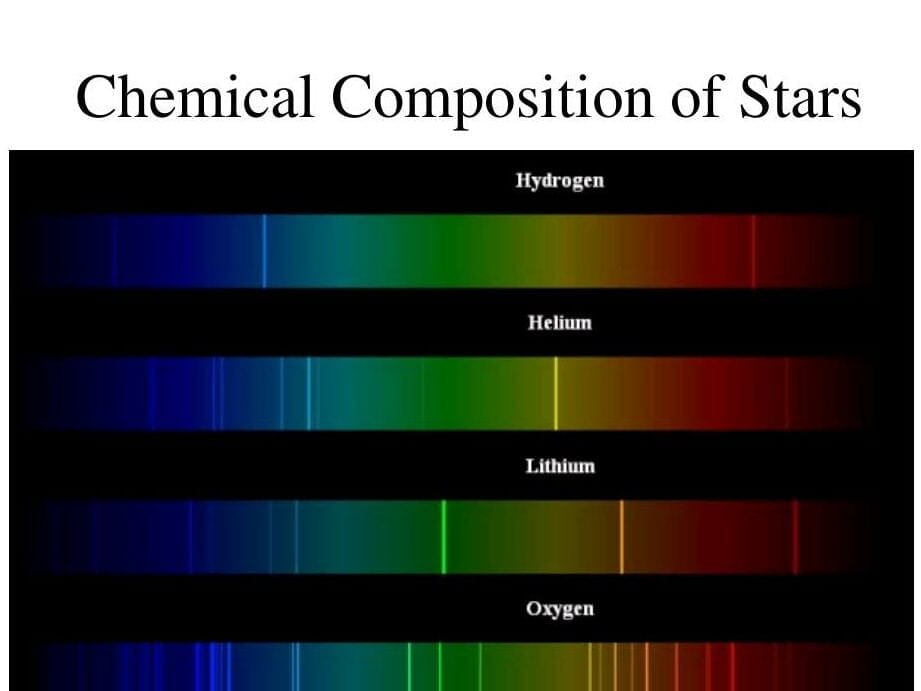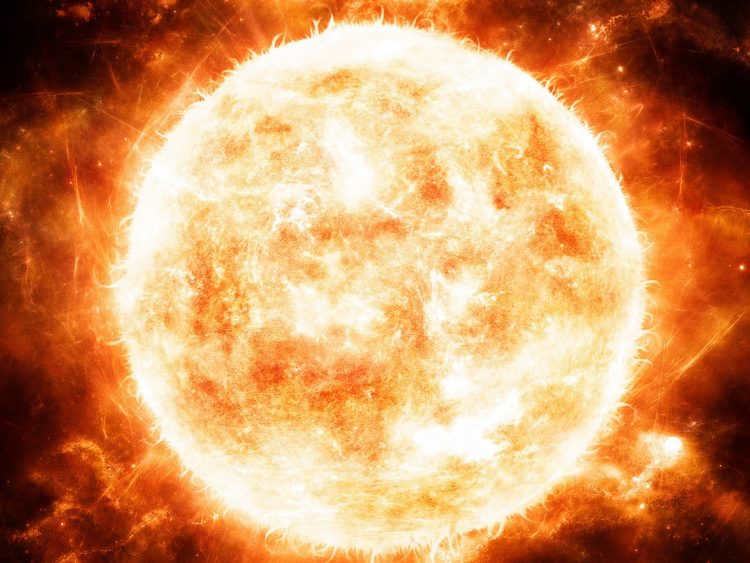
- Stars
Star – a massive celestial object made up of gas, emitting light and held together by its own gravity and internal pressure, in which thermonuclear fusion reactions occur (or have occurred in the past). The nearest star to Earth is Sun. The closest star to the Sun is Proxima Centauri. It is located 4.2 light-years away.
The chemical composition of stars was the most recent discovery made by humanity. The philosopher Immanuel Kant speculated about their origin in the 18th century. Other characteristics, such as color or brightness, can be estimated without special tools – but the material that makes up stars has long puzzled scientists.
Method of Determination
Astronomers discovered the composition of luminaries only in the 19th century. During this time, space explorers acquired the spectral analysis technique.
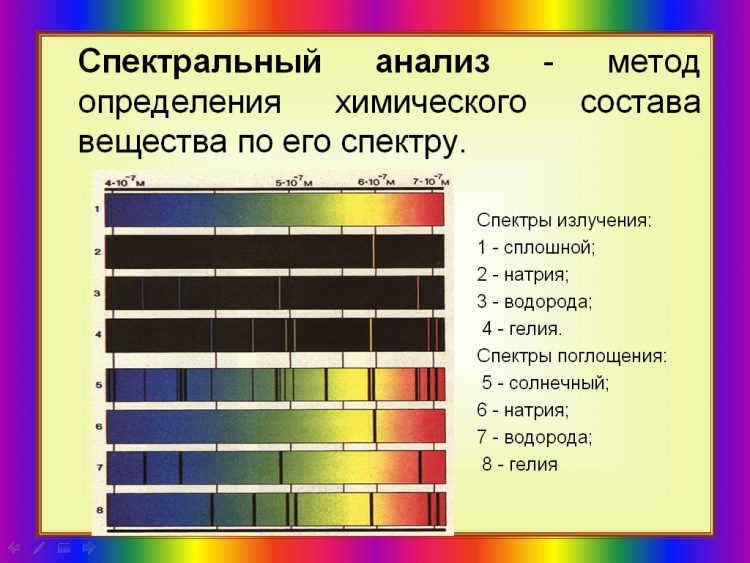
The technique is founded on the characteristic property of atoms from different elements to emit and absorb light at precise resonance frequencies. Consequently, the spectrum exhibits dark and light bands situated at distinct positions specific to a particular substance. The distinctive absorption and emission lines within the pattern enable the differentiation of diverse light sources.
Spectral analysis has been effectively employed for the determination of star composition. The collected data aids researchers in comprehending numerous processes taking place within the celestial bodies that are otherwise unobservable.
The Hertzsprung-Russell diagram is currently utilized for the classification of stars. It illustrates the correlation between absolute stellar magnitude, luminosity, spectral class, and the surface temperature of the star.
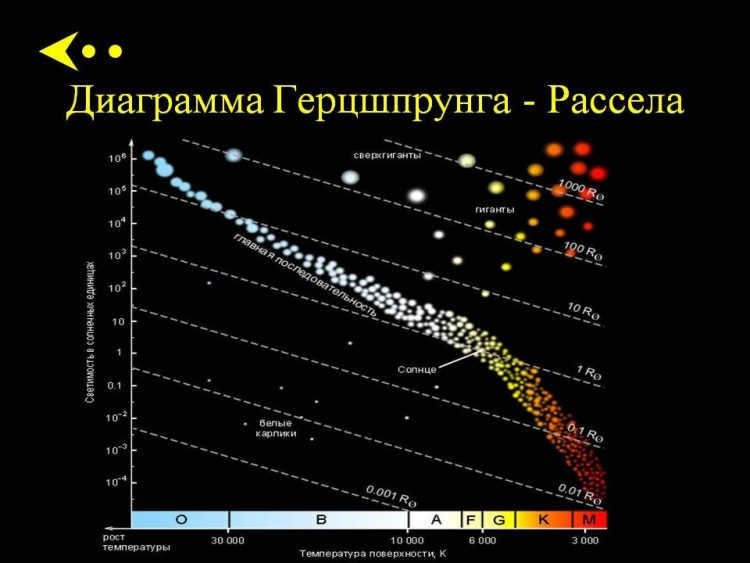
It is common knowledge that as the temperature increases, the composition of particles present in a star’s atmosphere becomes smaller. By conducting spectral analysis on stars of O, B, and A classes (with temperatures ranging from 50 to 10,000 degrees Celsius), scientists have discovered that the atmospheres of these stars contain ionized hydrogen, helium, and metal ions. Additionally, in K class stars (with a temperature of 5,000 degrees Celsius), they have detected the presence of radicals, and in M class stars (with a temperature of 3,500 degrees Celsius), they have found oxide molecules.
The elemental makeup of stars
Have you ever pondered over the composition of stars? It might astonish you to discover that they are composed of the same materials as the rest of the universe:
That’s right, with the exception of a few variations in specific elements, stars are predominantly composed of the same substances.
Stars have been undergoing formation since the inception of the universe. In fact, astronomers have computed that 5 fresh stars are born each year in the Milky Way galaxy. Some of these stars possess a greater abundance of heavy elements inherited from previous stars – they are considered metal-rich, while others have a lower concentration – they are known as metal-poor. Nonetheless, the proportion of elements remains consistently elevated.
The Sun, a star that is rich in metals, contains a greater quantity of heavy elements compared to other stars of its kind. Despite this, our star has a similar composition in terms of elemental proportions, with 75% hydrogen, 24% helium, and the remaining percentage consisting of oxygen, carbon, and nitrogen.
The process of converting hydrogen into helium in the core of the Sun has been ongoing for a duration of 4.5 billion years.
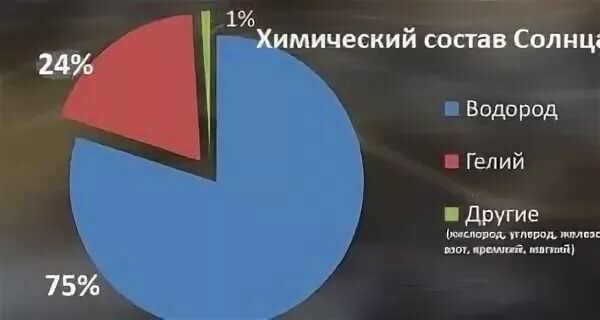
The chemical makeup of stars
The roster of stars encompassing the first four classifications is predominantly composed of lines representing helium and hydrogen, yet as the temperature gradually decreases, lines indicating the presence of other elements become detectable, possibly even suggesting the existence of compounds. Naturally, these compounds are rather basic and include titanium oxides (Class M), zirconium, and radicals. Typically, the outer layer of most stars consists primarily of hydrogen.
On average, for every 10 thousand hydrogen atoms, there are approximately a thousand helium atoms, only 5 oxygen atoms, and less than 1 atom of any other element.
Within the cosmos, there exists an abundant quantity of stars that possess an atypical arrangement of elements. In certain red giant stars that are in their early stages, scientists have discovered heightened levels of various heavy elements.
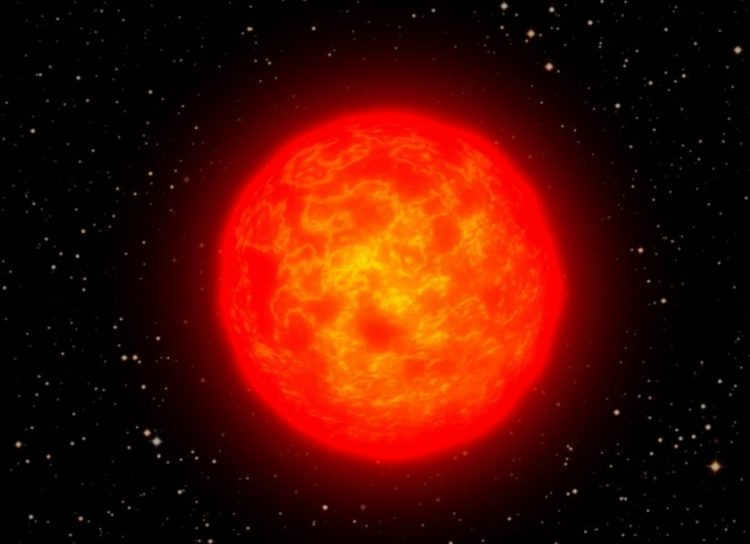
One star in particular has been discovered to possess an excessive amount of molybdenum, which was clearly overestimated. In fact, the Sun contains 26 times less molybdenum compared to this star.
As stars age, the amount of elements decreases in those stars that have atoms with greater mass than helium atoms.
The variations in the chemical composition of stars also rely on the location of the stars within the galaxy. In the older stars located in the spherical region of the galaxy, there are only a few heavy elements present. On the other hand, the peripheral peculiar spiral “arms” of the galaxy are home to numerous stars that contain a significant amount of heavy elements. Typically, this is where new stars are formed.
Scientists have concluded that the presence of heavy elements leads to a unique form of chemical evolution, which is characteristic of the early stages of a star’s life.
Changes in composition during the aging of a star
Over time, the composition of stars gradually changes due to thermonuclear reactions. The most common fusion reaction in stars, including our Sun, is the proton-proton cycle. In this process, four hydrogen atoms fuse together to ultimately form one helium atom, releasing a significant amount of energy, up to 98% of the star’s total energy.
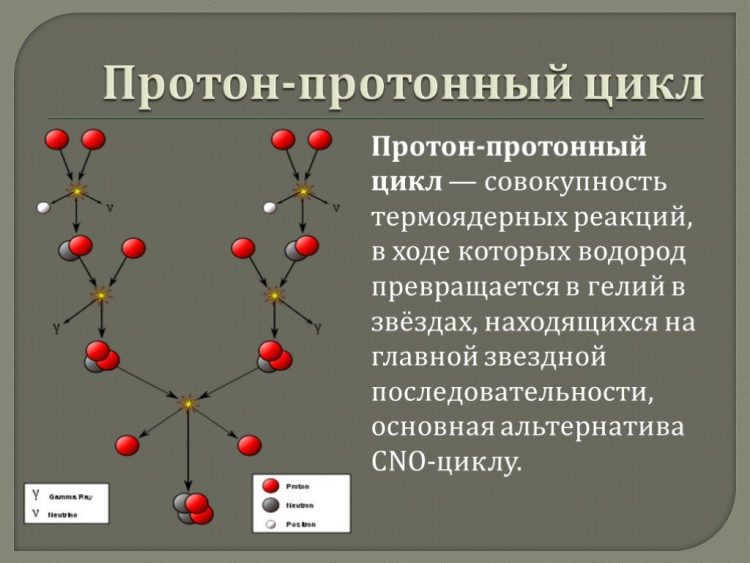
The process of hydrogen fusion in the Sun is also known as “burning”. Approximately 4 million tons of hydrogen are being fused in the Sun every second.
The Sun’s Changing Composition
The Sun’s core will experience an increase in helium content, resulting in the expansion of the core. As a result, the area of thermonuclear reaction will expand, leading to an increase in the Sun’s brightness and temperature. After 1 billion years (at the age of 5.6 billion years), the Sun’s energy will increase by 10%. In 3 billion years from now (at the age of 8 billion years), the solar radiation will be 140% of its current level.
The conditions on Earth will have undergone such significant changes by then that it will be strikingly similar to Venus.
The proton-proton reaction’s increase will have a significant impact on the star’s composition – hydrogen that has had minimal influence since its birth will burn at a much faster rate. The equilibrium between the Sun’s core and its shell will be disrupted – the hydrogen shell will expand while the helium core, conversely, will contract. At an age of 11 billion years old, the radiation emitted from the star’s core will be weaker than the force of gravity that is compressing it – it is currently the increasing compression that is generating heat within the core.
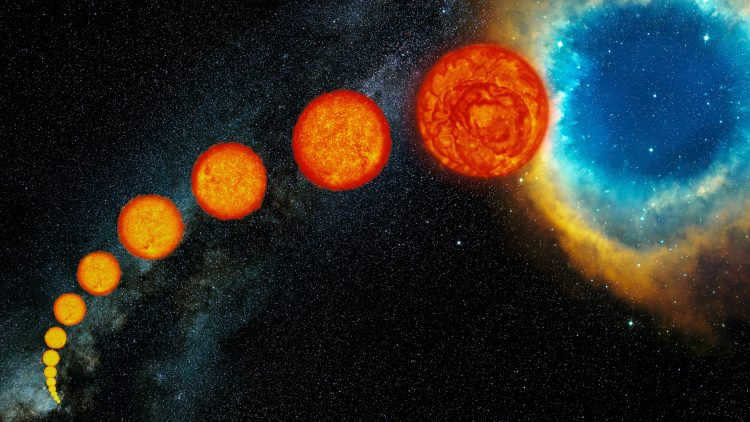
In approximately one billion years, there will be a significant alteration in the star’s composition. This change will occur when the temperature and compression of the Sun’s core reach such levels that the following stage of the thermonuclear reaction, known as “helium combustion,” takes place.
During this reaction, the atomic nuclei of helium come together, initially forming an unstable form of beryllium and eventually transforming into carbon and oxygen. The magnitude of this reaction is incredibly powerful, causing the Sun to ignite and shine up to 5,200 times brighter than its current state!
This is the process by which our Sun will eventually become a red giant. The Sun’s evolution will be complete when the outer layers of the star are depleted, leaving behind only a dense, hot, and compact core – a white dwarf. This core will gradually cool over billions of years.
The evolving composition of giant stars
The evolution of massive stars continues even further, extending all the way to the formation of iron. Iron. Heavier elements are also synthesized in these stars. Once these stars reach a certain point, they cannot reverse their course and will eventually explode in a supernova, resulting in the formation of either a black hole or a neutron star.
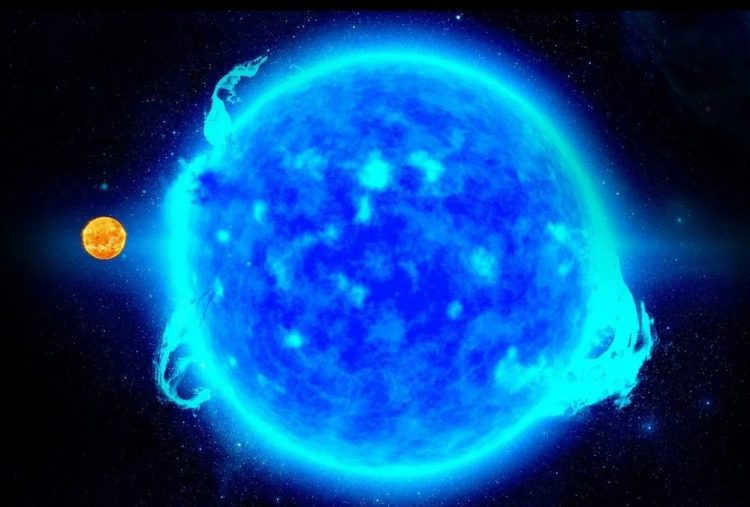
Despite the fact that both carbon and oxygen are present in the star simultaneously, they generate substances during fusion reactions that are distributed at different levels within the star.
For instance, carbon produces lightweight substances such as neon, sodium, and magnesium.
Oxygen, on the other hand, gives rise to heavier non-metals like sulfur and phosphorus, as well as light metals like aluminum. Together with nitrogen, they participate in the CNO cycle of hydrogen combustion, which is the primary thermonuclear process in large Main Sequence stars.
The star’s composition
Typically, a main-sequence star is made up of three distinct regions:
The central core – serves as the star’s powerhouse, where nuclear reactions take place.
The convective zone – facilitates energy transfer through convection. For stars with a mass less than 0.5 M☉, it encompasses the entire space from the core’s surface to the photospheric surface. For stars with a mass similar to that of the Sun, the convective zone is located at the uppermost part, above the radiant zone. In the case of massive stars, it is situated inside, below the radiant zone.
The region of radiation is where energy transfer takes place through the release of photons. In the case of massive stars, this region is situated between the core and the convective zone, while for low-mass stars it is nonexistent. As for stars with a greater mass than the Sun, it is found closer to the surface.
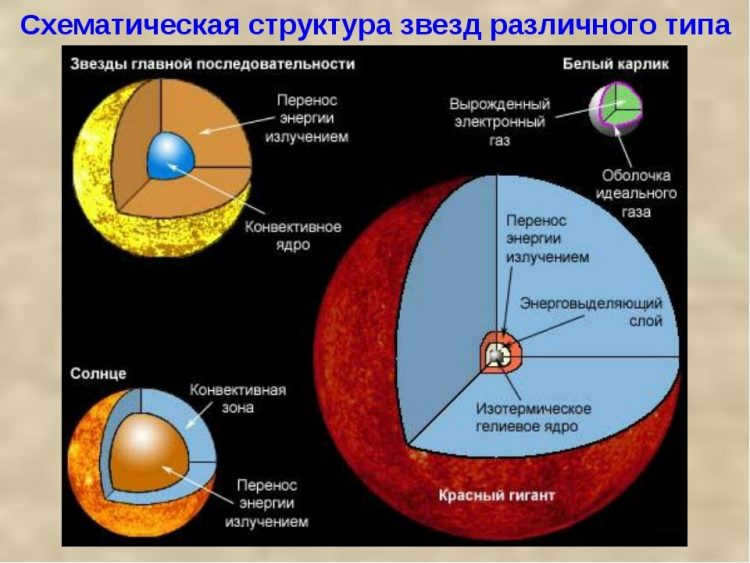
In later stages of stellar evolution, additional layers form where nuclear reactions involving elements other than hydrogen occur. The number of layers increases with the mass of the star. For stars with a mass 1-2 orders of magnitude greater than the solar mass, there can be up to 6 such layers. In the uppermost layer, hydrogen is still undergoing fusion, while in the lower layer, carbon is being transformed into heavier elements, including iron. At the core of the star, there is an inert iron core where nuclear reactions do not occur.
Above the star’s surface lies an atmosphere, typically consisting of three parts: the photosphere, chromosphere, and corona.
The Chromosphere (derived from the Greek word for “sphere of light”) gets its name from its reddish-violet hue. It can be observed as a delicate, luminous halo encircling the darkened disk of the Moon during a total solar eclipse, when the Moon fully obscures the Sun. The chromosphere displays a remarkable diversity, primarily characterized by elongated tongues called spicules, which resemble flickering blades of grass and contribute to its fiery appearance.
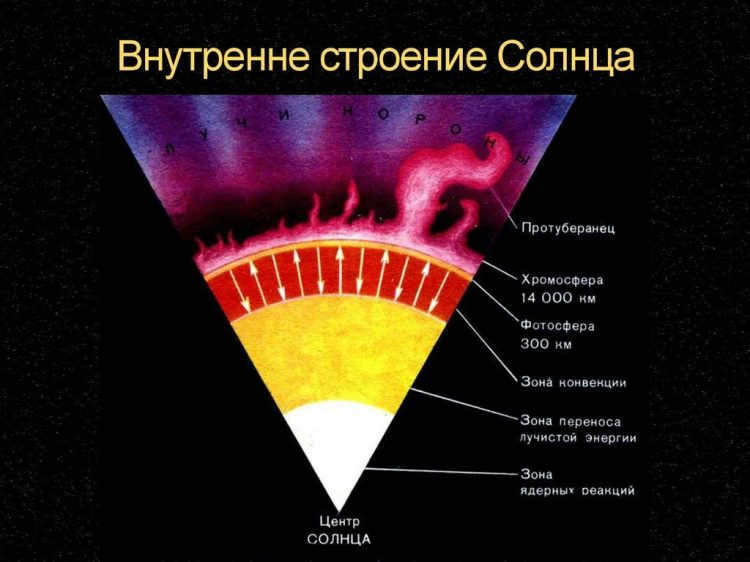
The corona is the outermost part of the Sun’s atmosphere, contrasting with the chromosphere and photosphere. This region has a significant length, spanning millions of kilometers, which is equivalent to several solar radii. The density of matter in the solar corona decreases at a slower rate with height compared to the density of air in Earth’s atmosphere.
According to Carl Sagan, a renowned American astronomer and science popularizer, all living beings and objects in our surroundings, including humans, planet Earth, and the entire cosmos, consist of matter that originated from the interior of stars. In other words, our composition is comprised of elements that were created through nuclear reactions and supernova explosions in stars.
However, it is possible that our composition consists not only of elements created within stars, but also of particles expelled by quasars.
Watch the Video
According to its definition, a star is a massive spherical object composed of gas that emits light and is held together by its own gravitational force and internal pressure. As we are aware, stars are formed from a combination of gas and dust that undergo gravitational compression. However, what precisely constitutes the composition of stars?
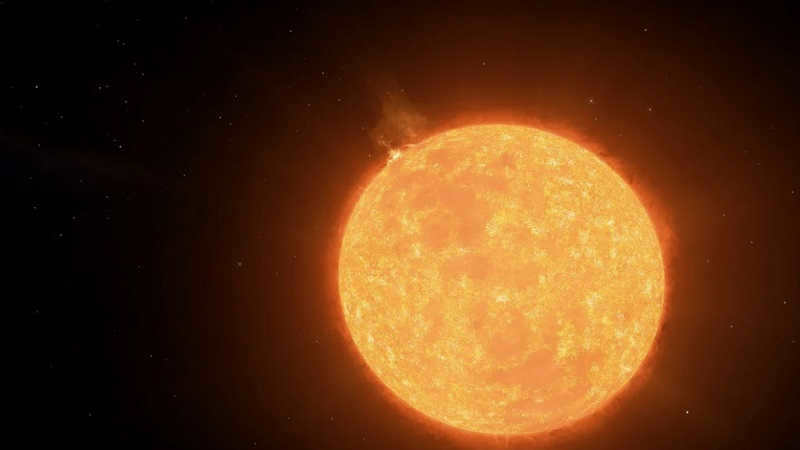
While each star is unique in its own way, they are created from the same building blocks. Hence, the chemical makeup of stars:
Hydrogen
As evident from the composition of stars, the predominant element is hydrogen. Interestingly, it is hydrogen that initiates nuclear reactions.
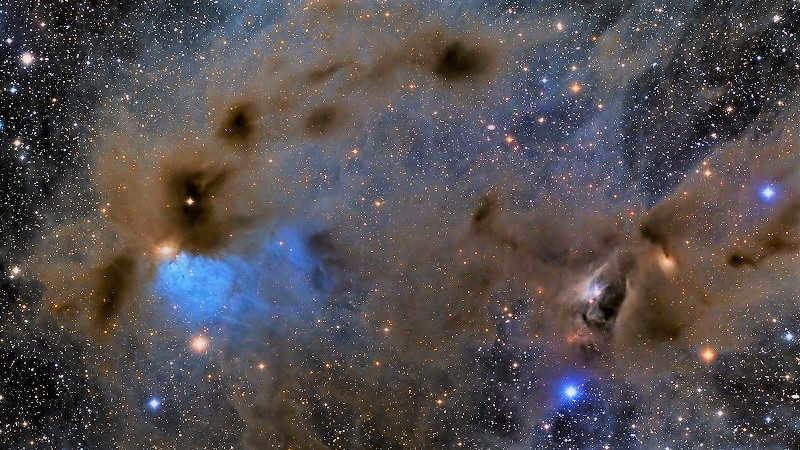
When the gas cloud is compressed, its internal temperature increases. As a result, thermonuclear reactions occur within the already existing nucleus. During this process, the four dominant hydrogen atoms in the vicinity merge together to form a single helium atom. In simpler terms, the hydrogen atoms start to undergo combustion, leading to the synthesis of helium. This is how the majority of the energy (approximately 98% of the total stellar energy) is generated.
Helium
It should be noted that helium is the second most abundant element in the chemical makeup of all celestial bodies. Additionally, it is the second lightest element, coming after hydrogen. This is likely why helium and hydrogen dominate the universe, surpassing all other elements. They are integral to the fabric of our cosmos.
As previously stated, helium is created through thermonuclear fusion. Furthermore, when subjected to the intense heat and combustion of hydrogen, it also ignites. This reaction results in the formation of a compact nucleus.
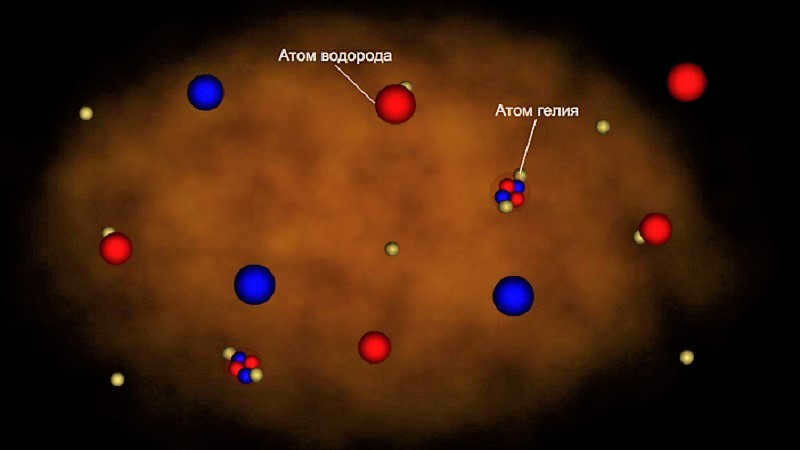
Simultaneously, the density of helium is increased due to gravitational compression, leading to a rise in temperature (indeed, it becomes progressively higher). Consequently, the radiation and the outer layer increase, causing it to cool down as it expands. As a result, the star undergoes growth and evolution. However, it is possible for the helium core to exhaust its fuel before the explosion or transform into a carbon core. This outcome is contingent upon the remaining composition of the star.
Although only 2% of the entire luminary is composed of substances heavier than helium, their significance is incredibly high. They have a significant impact on the rate of processes within the nucleus, either accelerating or decelerating them. This ultimately determines the luminosity and lifespan of the celestial body.
As you are aware, the deeper an element is located, the heavier it tends to be. This is due to the stronger gravitational forces that attract heavier elements. Conversely, lighter elements are found towards the outer regions.
Therefore, if there are elements in the chemical composition of a star that are heavier than hydrogen and helium, they will be situated in the core. If the star has an above-average mass and contains substances such as iron or other heavy elements, it will eventually undergo a supernova explosion. This, of course, does not happen immediately, but rather towards the final stages of the star’s evolution. However, the eventual outcome is clear – the star will either transform into a neutron star or collapse into a black hole.
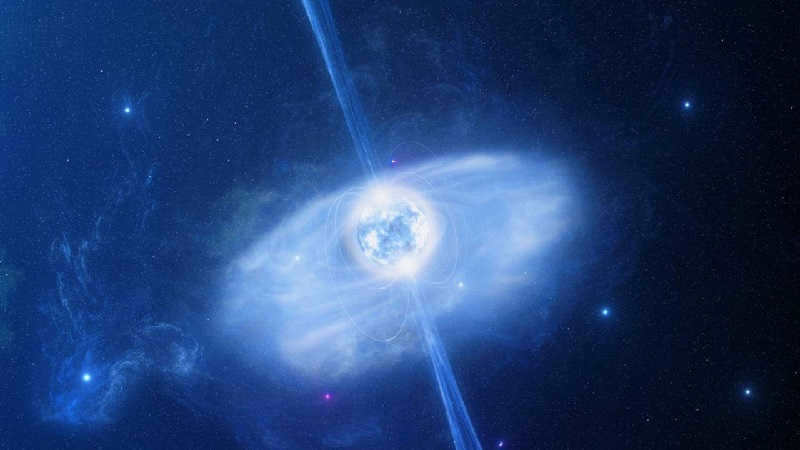
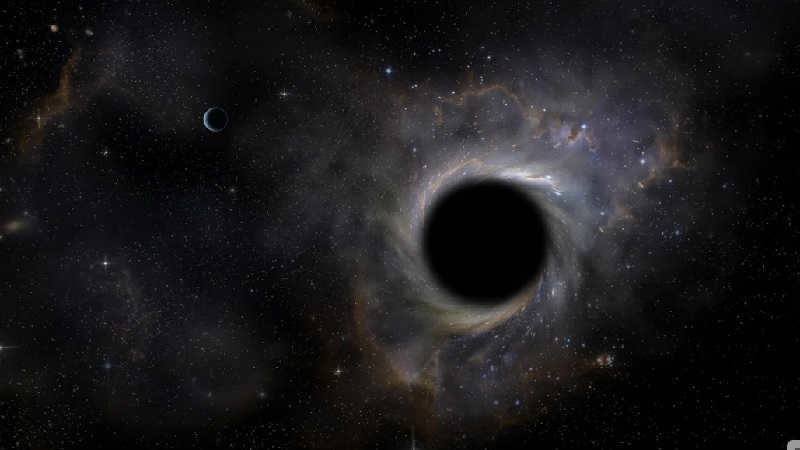
Scientists have discovered that stars can have a diverse chemical makeup, including silicon, iron, manganese, carbon, and other elements. These substances, which make up just 2% of the star’s composition, play a significant role in determining its destiny.
Stars are not only formed through thermonuclear processes but are also influenced by the interstellar medium. The initial composition of a star, which is a cloud of gas and dust, can already contain heavy elements. These elements become a part of the star’s composition without any conscious intention.
The interesting thing is that yellow and red dwarfs have a high abundance of heavy elements, while massive stars lack this characteristic.
If a massive star is dominated by metal atoms, then the resulting supernova explosion will leave behind a smaller residue.
The fundamental structure of stellar bodies
inner zone:
- The core, where thermonuclear reactions occur;
- The convective zone, where energy is transferred through the movement of matter;
- The radiative zone, where energy is transferred through photon emission. However, this zone is absent in low-mass stars.
During the course of evolution, stars of moderate and large masses accumulate additional layers where nuclear reactions occur, similar to those inside. The number of layers increases with the amount of mass. However, it is not hydrogen that undergoes combustion in these layers; rather, carbon transforms into heavier elements, including iron.
Located above the star’s surface, the outer region is similar to the inner region and is divided into three zones:
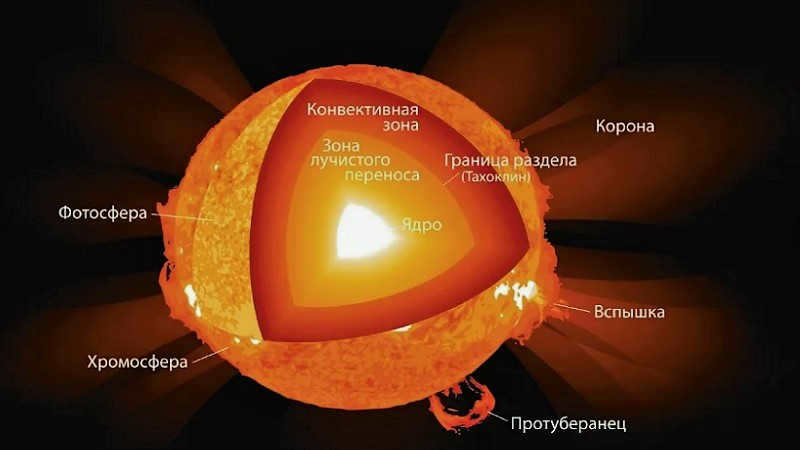
- The photosphere is located at the lowest point, where the spectrum is created;
- The chromosphere encompasses the lower section and is typically red in color due to hydrogen radiation;
- The corona is the outer zone of the atmosphere composed of plasma and emitting X-rays.
Discovering the Composition of Stars
Ancient civilizations marveled at the beauty of the stars that adorned the night sky. Over time, they began to study the colors and brightness of these celestial objects, even making estimations of their distance. However, the true composition of stars remained a mystery for centuries. It wasn’t until the mid-19th century, with the development of spectral analysis techniques, that scientists were able to unveil the secrets of the stars.
Through spectral analysis, scientists discovered that each light source has its own unique spectrum, which is influenced by the elements present. By studying the absorption and transmission of spectral lines, researchers were able to identify the specific elements that make up a star’s composition.
Interestingly, the chemical composition and mass of stars also provide insights into their age and ultimate fate.
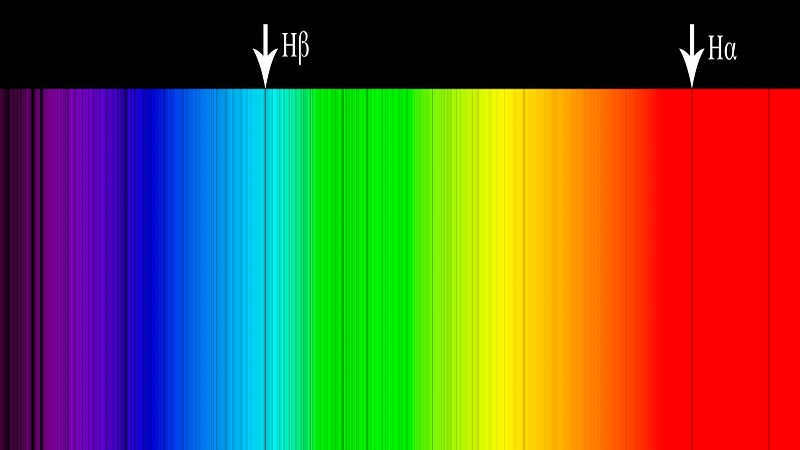
By the way, there is a whole field of scientific study dedicated to investigating the composition and nature of stars – Astrophysics. It is this discipline that examines the structure, physical properties, and chemical makeup of celestial objects.
To reiterate, it is worth noting that the specific chemical composition of stars determines their life trajectory and the various stages of evolution they will undergo. Additionally, it plays a role in the formation of other cosmic entities within our Universe, particularly those in which the star will eventually reside and contribute to their formation.

During the year 1665, a gifted physicist and mathematician from England, by the name of Isaac Newton, made an intriguing observation while perfecting telescopes. He noticed that the image produced by the lens had colorful edges. This phenomenon captivated the young scientist, who was only 21 years old at the time, and he was determined to uncover the true nature behind the enigmatic colored bands.
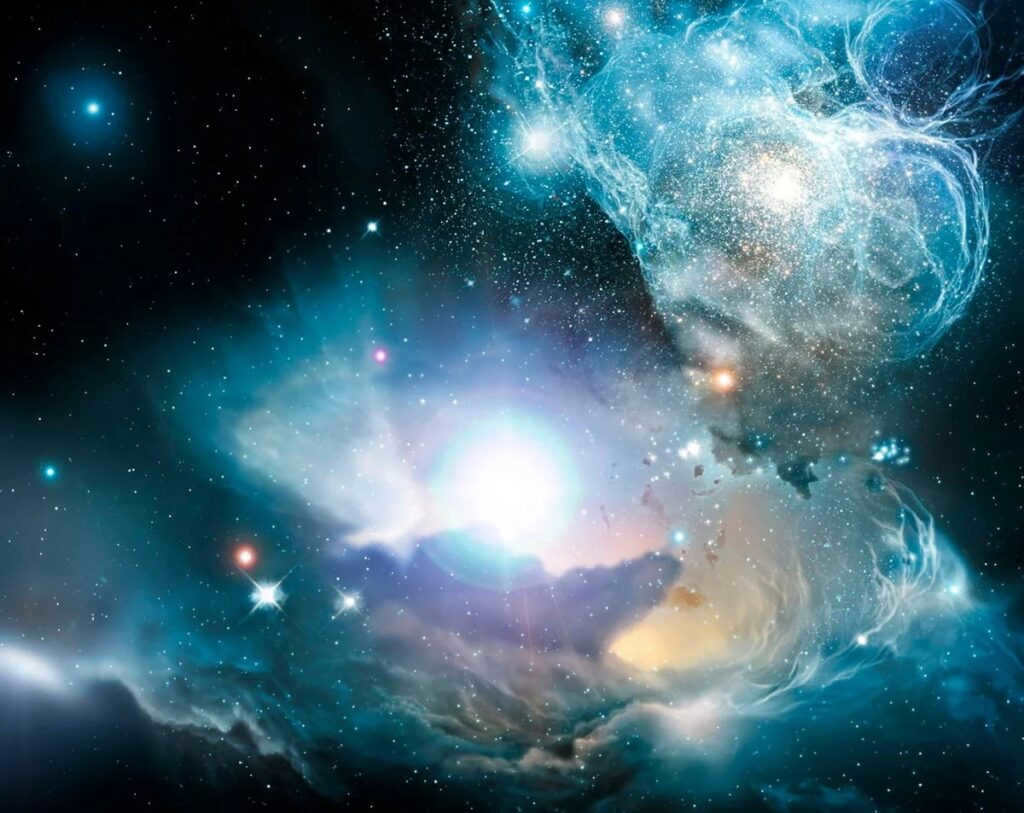
During that period, the Great Plague (1665-1666) was widespread in England, and Newton found himself seeking refuge in his hometown of Woolsthorpe. Prior to his departure, the scientist purchased prisms of varying sizes with the intention of making a groundbreaking discovery.
A brief overview of the experiment
Immersed in darkness during daylight hours, Newton created a small aperture in the window shutter. Positioned opposite the incoming beam of sunlight, he systematically placed the glass prisms.
The white light passing through the prisms produced a wall projection in the form of a striped pattern composed of alternating colors. Newton then categorized this resulting spectrum of sunlight into seven distinct colors, commonly known as the rainbow: red, orange, yellow, green, blue, indigo, and violet. This monumental achievement marked the first-ever observation of the sunlight spectrum.

Spectral analysis, a technique developed by Isaac Newton, allows for the qualitative and quantitative determination of an object’s composition by studying the interaction of matter with radiation. It involves decomposing a beam of white light into its component parts, resulting in a spectrum consisting of a continuous series of colored bands.
Light and the composition of stars
In 1802, the Sun was analyzed by the English chemist William Hyde Wollaston, who observed peculiar dark lines in its spectrum but could not explain their nature.
In 1814, the German physicist Joseph Fraunhofer discovered 574 mysterious dark bands in the Sun’s spectrum and made a remarkable discovery: these dark bands are like “punctuation marks” in the “sentence” that represents the chemical composition of the solar atmosphere.
To simplify this concept, we can think of it as breaking down light into a continuous spectral line, which is occasionally interrupted by a dark band known as the Fraunhofer line.
Following the Fraunhofer line, the continuous spectral line persists until another band emerges, and so forth. For instance, if the wavelength (continuous, prior to the appearance of the dark band) measures 8987.65 Angstroms (1 Angstrom = 0.1 nanometer), it indicates the presence of oxygen in the composition of the object whose radiation has been disintegrated into a spectrum. In the case of a wavelength of 5270.39 Angstrom – iron, 5889.95 Angstrom – sodium, and so on for all chemical elements.
Thanks to spectroscopic analysis in 1868, an erstwhile unknown chemical element called helium was discovered in the spectrum of the Sun. Who would have imagined that this element would be the second most abundant in the Universe after hydrogen!
Astronomy on the verge of a revolution
Almost a century later, with the advancement of technology, astronomers finally had the means to analyze the light emitted by stars situated tens, hundreds, or even thousands of light years away from our planet. By studying the light from these distant stars, scientists were able to determine their precise chemical composition with an unprecedented level of accuracy. Surprisingly, they discovered that virtually all stars shared the same chemical makeup, suggesting that the entire universe was uniformly composed.
However, it would be hasty to draw conclusions about the entire cosmos solely based on observations of stars within the Milky Way galaxy. Astronomers yearned to expand their investigations beyond our galaxy’s boundaries in order to gain insights into the chemistry of the most remote corners of outer space. But how could this be accomplished? After all, individual stars located billions of light years away appeared indistinguishable and were seemingly impossible to analyze…
And this is where quasars come in – these are the active nuclei of galaxies at the early stages of their development, where a supermassive black hole absorbs surrounding matter to form an accretion disk.
It is worth noting that quasars are among the brightest and most distant objects from Earth.
In the latter half of the 20th century, when numerous quasars were discovered, some of which were located nearly 12.5 billion light years away (the age of the Universe being 13.8 billion years), astronomers began to conduct spectral analysis on this ancient radiation, which has been traveling through the “black box” of the Universe towards Earth for billions of years.
Thanks to this discovery, it became clear that the Universe is teeming with elements that we are familiar with from the periodic table. It’s remarkable how uniform the vast expanse of cosmic space is.
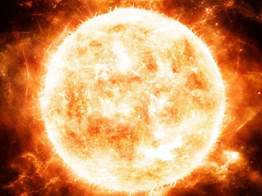
Task #1
Review the lecture material on the subject
Complete table 1 – Characteristics of stars.
Star – a massive sphere of gas that emits light and is maintained in a state of balance by the forces of its own gravity and internal pressure, where thermonuclear fusion reactions occur (or have occurred in the past). The Sun is the closest star to Earth. The closest star to the Sun is Proxima Centauri, located 4.2 light-years away.
1. Method of determination
It was not until the mid-19th century that astronomers developed a method to determine the composition of celestial bodies. This method, known as spectral analysis, became an essential tool for space researchers.
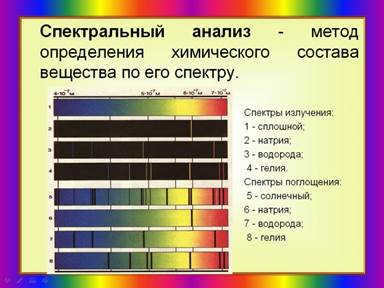
The technique relies on the characteristic emission and absorption of light by atoms of different elements at specific resonance frequencies. Consequently, the spectrum exhibits dark and light bands located at distinct positions unique to a particular substance. The distinctive pattern of absorption and emission lines allows for the differentiation of different light sources.
Spectral analysis has proven to be effective in determining the composition of stars. The data obtained through this method assists researchers in gaining insights into numerous processes taking place within celestial bodies that are otherwise unobservable.
The Hertzsprung-Russell diagram is presently employed to classify stars. It exhibits the correlation among the stellar magnitude in absolute terms, luminosity, spectral category, and the surface temperature of the star.
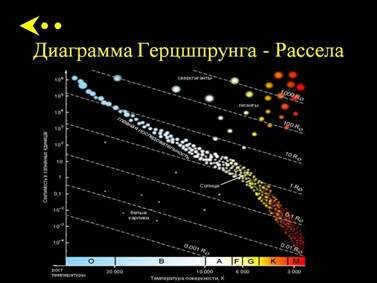
It is common knowledge that as the temperature increases, the types of particles that can be found in a star’s atmosphere decrease. By analyzing the spectra of O, B, and A class stars (with temperatures ranging from 50 to 10,000 degrees Celsius), researchers have discovered that the atmospheres of these stars contain ionized hydrogen, helium, metal ions. Additionally, in K class stars (with a temperature of 5,000 degrees Celsius), they have detected radicals, and in M class stars (with a temperature of 3,500 degrees Celsius), they have found oxide molecules.
Have you ever pondered the composition of stars? It may surprise you to discover that they are made up of the same materials as the rest of the universe:
That’s right, with the exception of some variations in certain elements, stars are primarily composed of the same substances.
Stars have been forming since the beginning of the universe. In fact, astronomers have estimated that the Milky Way galaxy alone sees the creation of 5 new stars each year. Some of these stars have a higher concentration of heavy elements from previous stellar generations – they are considered metal-rich, while others have a lower concentration – they are considered metal-poor. However, the overall ratio of elements remains consistently high.
The Sun, which serves as an example of a metal-rich star, contains a greater amount of heavy elements compared to the average among similar stars. Nevertheless, our star maintains a similar ratio of elemental proportions: 75% hydrogen, 24% helium, and the remainder consisting of oxygen, carbon, and nitrogen.
The process of converting hydrogen into helium within the core of the Sun has been occurring for 4.5 billion years.
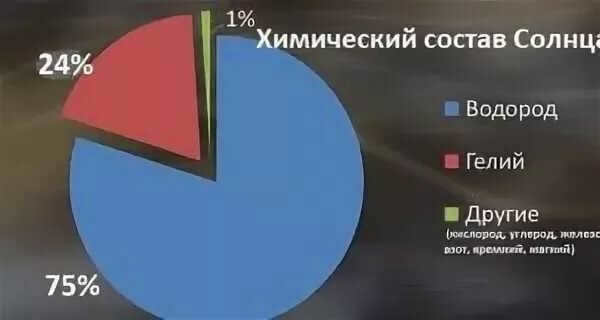
The composition of stars in terms of chemical elements
When looking at the stars belonging to the first four classes, the main chemical elements present are helium and hydrogen. However, as the temperature decreases, other elements start to appear, possibly indicating the presence of compounds. These compounds, though, are relatively simple, such as titanium oxides (in class M stars), zirconium, and various radicals. The outer layer of most stars is predominantly made up of hydrogen.
On average, for every 10 thousand hydrogen atoms, there are about a thousand helium atoms, only 5 oxygen atoms, and less than 1 atom of any other element.
It is not uncommon to discover stars with an augmented concentration of a specific element in their chemical makeup. Scientists are aware of stars that possess an increased quantity of a specific element in their chemical composition, such as silicon stars and iron stars. Moreover, numerous stars exhibit elevated levels of other elements like manganese and carbon.
In the vast expanse of the cosmos, there exists a considerable multitude of stars that display an anomalous arrangement of elements. In certain young stars of the red giant variety, researchers have detected heightened amounts of various heavy elements.
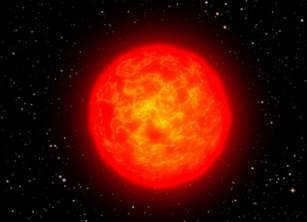
An excessive amount of molybdenum has been detected in one of these stars, and interestingly, the Sun contains 26 times less molybdenum than this star.
As stars grow older, their elemental composition decreases, especially in stars with atoms that have a higher mass than helium atoms.
The chemical composition of stars is also influenced by their location in the galaxy. Old stars located in the spherical region of the galaxy have a scarcity of heavy elements. Conversely, the peripheral spiral “arms” of the galaxy contain numerous stars rich in heavy elements. Typically, these regions are where new stars are formed.
Based on this, scientists have concluded that the presence of heavy elements plays a significant role in the chemical evolution that marks the inception of a star’s existence.
As time goes on, the composition of stars undergoes gradual changes due to thermonuclear reactions taking place within them. One of the primary and most basic fusion reactions that happens in the majority of stars in the universe, including our Sun, is the proton-proton cycle. This process involves the fusion of four hydrogen atoms to eventually produce one helium atom along with a significant release of energy, accounting for up to 98% of the total energy of the star.
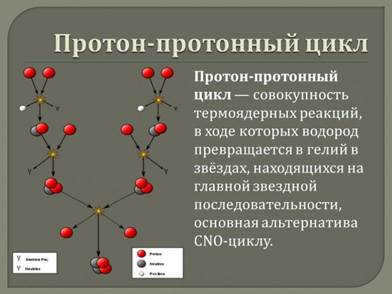
This phenomenon is also known as the “combustion” of hydrogen: the Sun consumes about 4 million tons of hydrogen per second.
The evolving composition of the Sun
The amount of helium in the Sun’s core will increase, causing the core to expand. As a result, the region of thermonuclear reaction will enlarge, leading to an increase in the Sun’s brightness and temperature. After 1 billion years (at the age of 5.6 billion years), the star’s energy will rise by 10%. In 3 billion years (at the age of 8 billion years), solar radiation will be 140% higher than today’s radiation.
By that time, the conditions on Earth will have undergone such significant changes that it will bear a striking resemblance to Venus.
The increase in proton-proton reactions will have a profound impact on the star’s composition – hydrogen, which has remained relatively unaffected since its inception, will burn up at a much faster rate. This disruption will disturb the balance between the Sun’s shell and its core – the hydrogen shell will expand while the helium core will contract. At the ripe old age of 11 billion years, the radiation emitted from the star’s core will be overshadowed by the gravitational forces compressing it – it is the increasing compression that now generates the core’s heat.
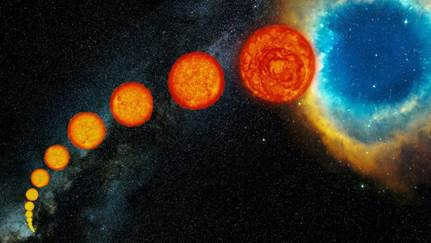
In approximately one billion years, there will be a notable alteration in the composition of the star. This transformation will occur when the temperature and compression of the Sun’s core reach such high levels that the subsequent stage of the thermonuclear reaction, known as “helium combustion,” takes place.
During this reaction, the atomic nuclei of helium are initially fused together to form an unstable form of beryllium and subsequently transform into carbon and oxygen. The energy released during this reaction is incredibly intense, causing the Sun to flare up and become 5,200 times brighter than its current state!
Throughout these processes, the Sun’s core will continue to increase in temperature, while the outer layer will expand outwards to the extent of the Earth’s orbit and experience a significant decrease in temperature. The larger the area of radiation, the greater amount of energy the Sun will lose. Additionally, the mass of the Sun will be impacted. Specifically, the Sun will release its reserves of helium and hydrogen, as well as newly created carbon and oxygen, into the vast expanse of space.
This is the process by which our Sun will transform into a red giant. Eventually, the Sun’s evolution will reach its conclusion when its outer layer is completely depleted, leaving behind only a dense, hot, and compact core known as a white dwarf. Over the course of billions of years, this white dwarf will gradually cool down.
The process of star evolution is much more extensive in the case of large stars: it extends down to the formation of iron. Iron is not the only element produced, as heavier elements are also synthesized. Once these stars reach the end of their lifecycle, they will undergo a supernova explosion, resulting in the formation of either a black hole or a neutron star.
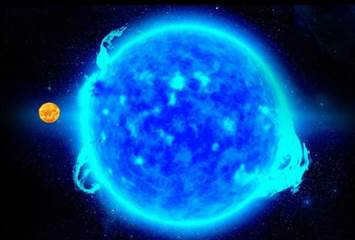
Despite the simultaneous presence of carbon and oxygen in the star, they give rise to substances that are distributed at distinct levels within the star during fusion reactions.
For instance, carbon generates lighter substances such as neon, sodium, and magnesium.
Oxygen, on the other hand, produces heavier non-metals like sulfur, sulfur, and phosphorus, or more volatile metals like aluminum, aluminum. Together with nitrogen, they participate in the CNO cycle of hydrogen burning, which is the primary thermonuclear process in large Main Sequence stars.
The Composition of a Star
Typically, a main-sequence star encompasses three distinct regions:
The Core – serves as the central hub of the star where nuclear reactions transpire.
The Convective Zone – facilitates energy transfer through convection. In stars with masses below 0.5 M ☉, this zone extends from the core surface to the photospheric surface. In stars with masses similar to the Sun, the convective region is located at the highest point, above the radiant zone. Conversely, in massive stars, it resides within the radiant zone.
The luminous region is the area where energy is transferred by emitting photons. In the case of large stars, this region is situated between the core and the convective zone, while it is non-existent for small-mass stars. However, for stars with a greater solar mass, it can be found near the surface.
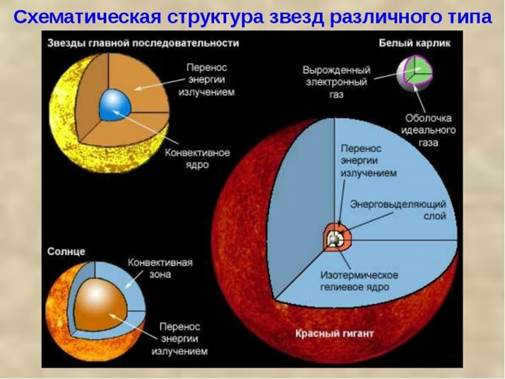
During later stages of stellar evolution, additional layers are formed where nuclear reactions occur with elements other than hydrogen. The number of these layers increases with the mass of the star. In stars that are 1-2 orders of magnitude larger than the mass of the Sun, up to 6 layers can exist. In the uppermost layer, hydrogen is still undergoing fusion, while in the lower layer, carbon is being transformed into heavier elements, including iron. At the core of the star, there is an inert iron core where no nuclear reactions occur.
Above the star’s surface, there is an atmosphere that typically consists of three parts: the photosphere, chromosphere, and corona.
The chromosphere gets its name from the reddish-violet hues that it displays. It can be seen as a faint, glowing ring around the dark silhouette of the Moon during a total solar eclipse, when the Moon completely blocks out the Sun. This outer layer of the Sun’s atmosphere is highly diverse and is composed primarily of elongated structures called spicules, which resemble flaming blades of grass.
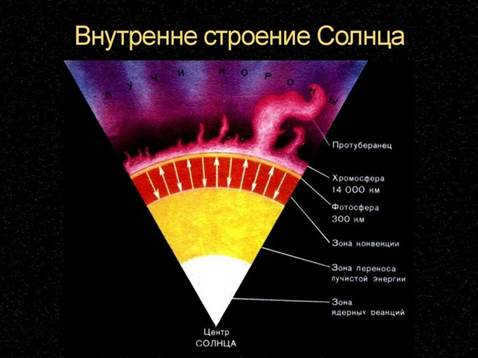
The corona, which is the outermost layer of the Sun’s atmosphere, differs from the chromosphere and photosphere. It is characterized by its enormous length, stretching over millions of kilometers, equivalent to several solar radii. Unlike the density of air in the Earth’s atmosphere, the density of matter in the solar corona decreases at a much slower rate with increasing height.
According to the renowned American astronomer and science popularizer, Carl Sagan, it is believed that everything in our universe, including humans, planet Earth, and all other celestial bodies, is composed of matter that originated within stars. In other words, the elements that make up our existence were formed through the nuclear reactions and explosive supernovas of stars.
However, it is possible that our composition goes beyond just matter created within stars. There is a fascinating notion that we may also consist of dust that was expelled by quasars.
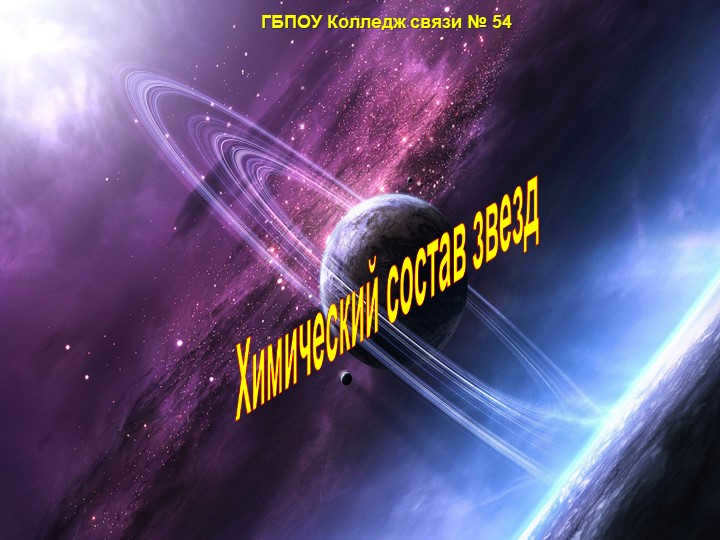
Currently, there are additional cumulative discounts (ranging from 2% to 25%) available for 58,742 educational institutions. To determine the applicable discount for all staff members of your educational institution, please log in to your personal Infoworks account.


Professional development program
Arranging cross-cultural adaptation for international students in professional educational organizations.
We can include your educational institution’s discount along with this offer (the discount amount will depend on the number of your colleagues who have enrolled in Infowork courses).
Currently, 58,742 educational institutions are eligible for additional discounts ranging from 2% to 25%. To find out the discount applicable to all staff members of your institution, please log in to your personal Infoworks account.


Professional development course
Designing the object and play space of preschool educational organization in accordance with the Federal State Standard for Preschool Education and Science (FSES)
You can receive an additional discount for this course if your educational institution qualifies. The discount amount depends on the number of your colleagues who have already taken Infoworks courses.
Currently, there are 58,742 educational institutions that are eligible for additional discounts ranging from 2% to 25%. To find out what discount is available for all employees of your educational institution, please sign in to your personal Infoworks account.


Developing reading skills in students during classroom instruction
Summary of the presentation through separate slides:

Slide 2: The celestial entities have perpetually captivated the attention of mankind. Apart from the most radiant star, the Sun, our galaxy boasts an immense multitude of other stars that form an unparalleled design in the obscurity.
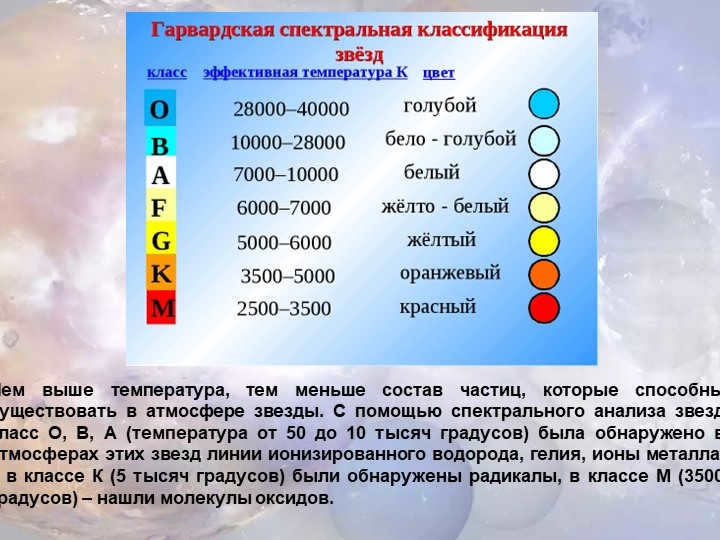

Slide 3 As the temperature of a star increases, the range of particles that can exist in its atmosphere becomes smaller. By analyzing the spectra of stars in the O, B, and A classes (with temperatures ranging from 50 to 10 thousand degrees), scientists have discovered lines corresponding to ionized hydrogen, helium, and metal ions. In stars of class K (with temperatures around 5 thousand degrees), radicals have been observed, and in stars of class M (with temperatures around 3500 degrees), molecules of oxides have been found.
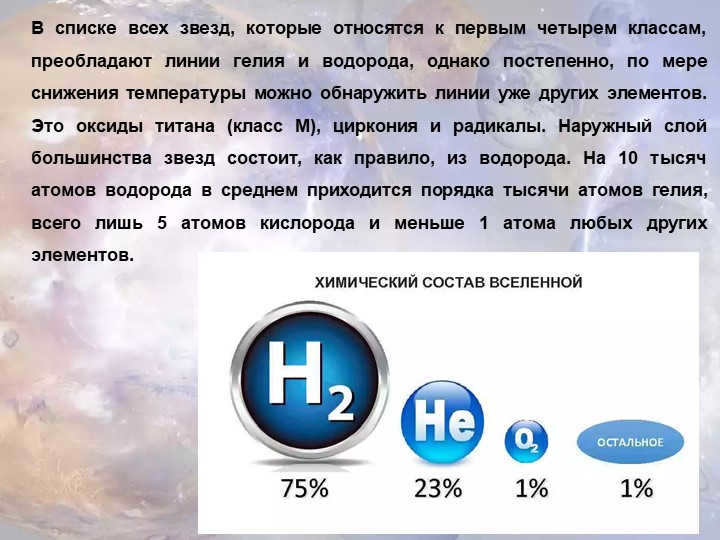
When it comes to the first four classes of stars, the majority of them exhibit helium and hydrogen lines. However, as the temperature decreases, lines from other elements start to become noticeable. These elements include titanium oxides (in class M stars), zirconium, and various radicals. Typically, the outer layer of most stars is predominantly composed of hydrogen. On average, for every 10,000 hydrogen atoms, there are around a thousand helium atoms, only five oxygen atoms, and less than one atom of any other elements.
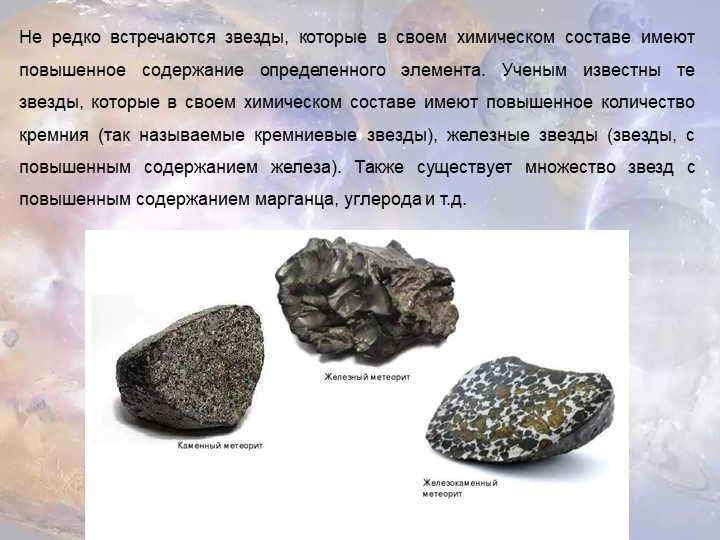

It is not unusual to come across stars that possess a heightened level of a specific element in their chemical makeup. Scientists have identified stars that exhibit an increased concentration of silicon (known as silicon stars), as well as stars with an elevated iron content (referred to as iron stars). Additionally, there are numerous stars that display elevated levels of manganese, carbon, and other elements.
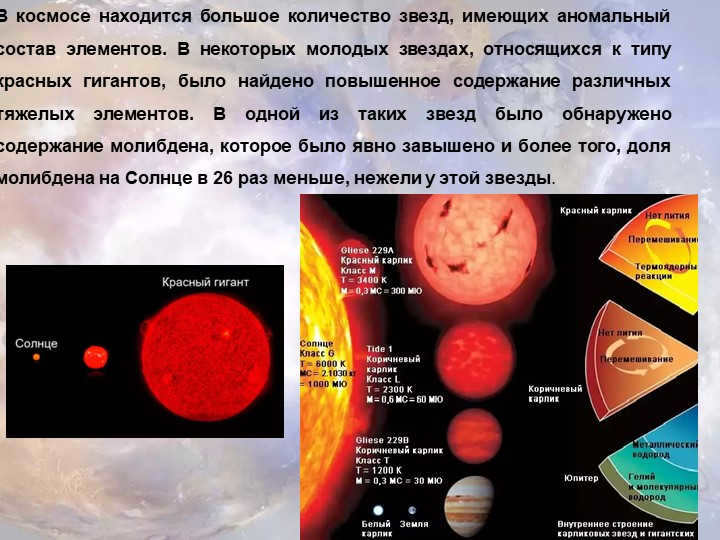

There is a significant amount of stars in the vast expanse of outer space that possess atypical element compositions. Some young red giant stars have been discovered to contain elevated levels of various heavy elements. In particular, one star was found to have an exaggerated amount of molybdenum, with its concentration exceeding that of the Sun by a factor of 26.
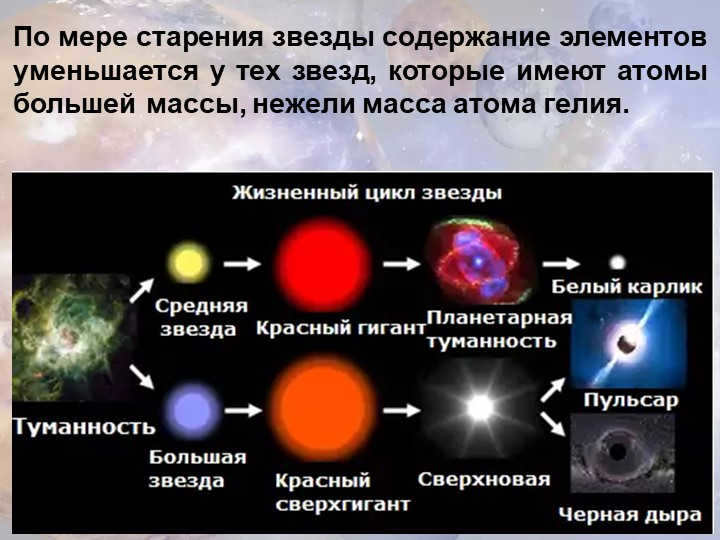

7 slide As stars age, the proportion of elements decreases in stars that consist of atoms with a greater mass than helium.
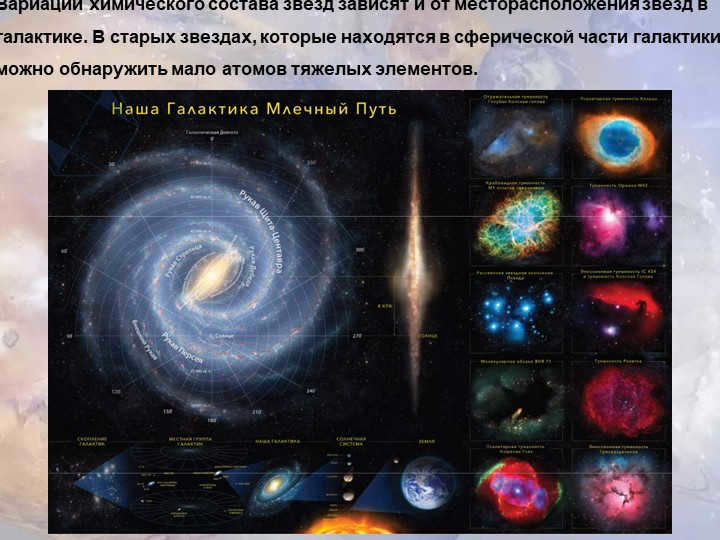

Slide 8: The chemical composition of stars varies depending on their location within the galaxy. In the spherical region of the galaxy, old stars contain only a small amount of heavy elements.
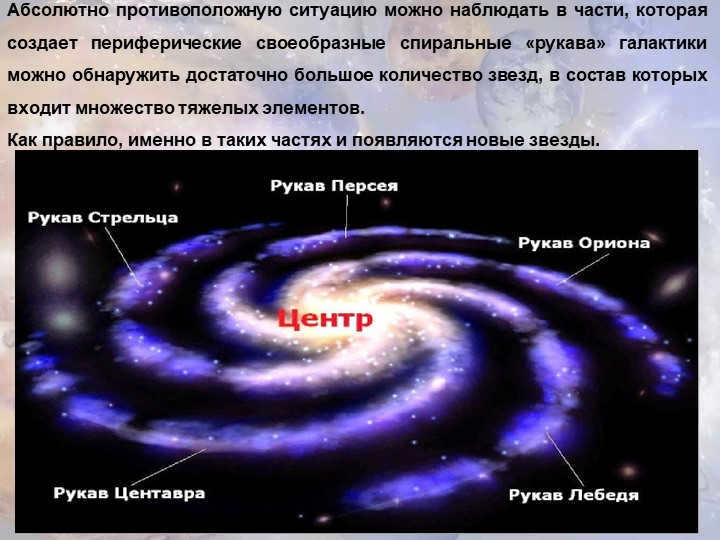
On Slide 9, we can observe the complete opposite scenario in the region responsible for forming the galaxy’s peripheral unique spiral “arms”. Here, there is a significant concentration of stars that possess a multitude of heavy elements. Typically, it is in these regions that new stars are born.
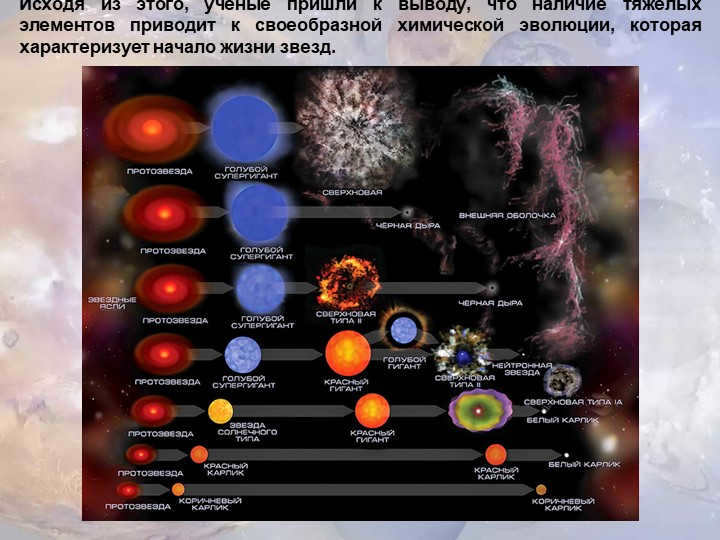

By analyzing this data, researchers have deduced that the existence of heavy elements is responsible for propelling a particular type of chemical transformation that signifies the commencement of star formation.
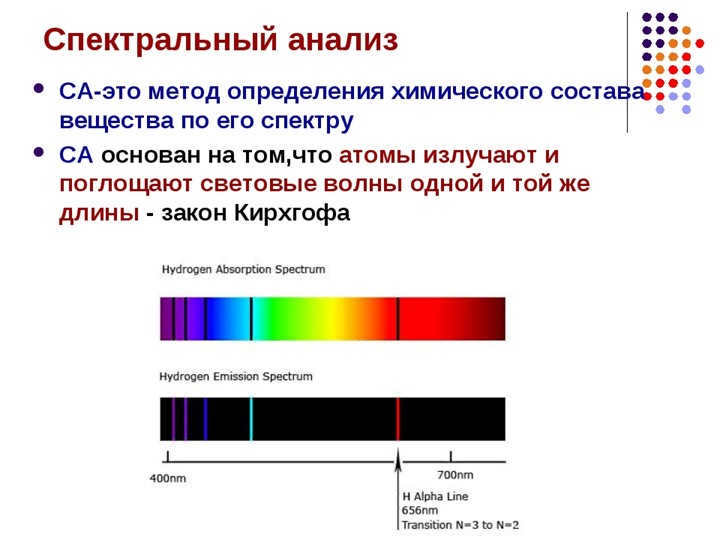
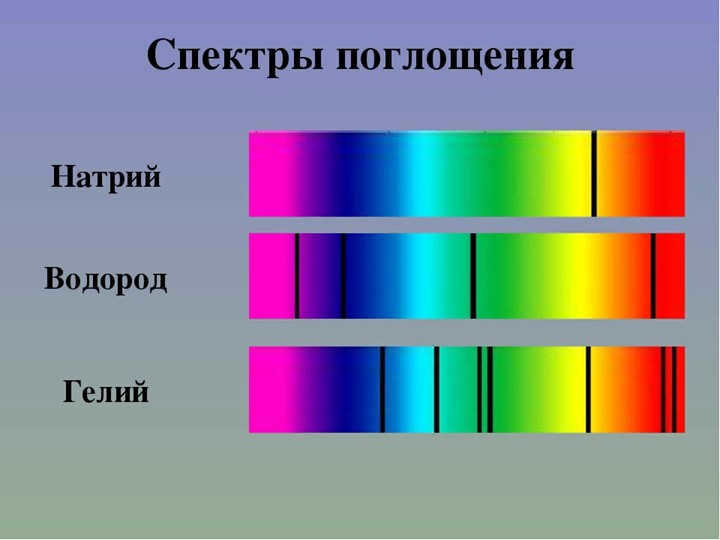

Summary of the Document:
Greetings, I will be presenting on the fascinating subject of “Stellar Chemical Composition.”
The celestial bodies in the sky have forever captured the attention of humanity. Alongside the most radiant star, our Sun, our galaxy is home to an immense number of other stars that form a distinctive arrangement in the darkness.
It is widely known that as the temperature of a star increases, the types of particles capable of existing in its atmosphere diminish. By employing spectral analysis on stars belonging to classes O, B, and A (with temperatures ranging from 50 to 10,000 degrees), scientists have identified lines of ionized hydrogen, helium, and metal ions in their atmospheres. In class K stars (at 5,000 degrees), radicals have been detected, while in class M stars (at 3,500 degrees), oxide molecules have been observed.
Within the list of stars categorized into the initial four classes, the predominant spectral lines are those of helium and hydrogen. However, as the temperature decreases, one can observe lines from other elements gradually appearing, potentially indicating the presence of compounds. Naturally, these compounds are relatively straightforward, such as oxides of titanium (class M), zirconium, and radicals. Typically, the outer layer of most stars consists primarily of hydrogen. On average, there are around 10,000 hydrogen atoms for every 1,000 helium atoms, merely 5 oxygen atoms, and less than 1 atom of any other element.
It is not unusual to come across stars that possess an augmented presence of a particular element in their chemical composition. Scientists are acquainted with stars that exhibit an amplified quantity of silicon in their chemical composition (commonly known as silicon stars) and stars with an increased iron content (referred to as iron stars). Additionally, there are numerous stars that showcase an enhanced content of manganese, carbon, and other elements.
There exists a considerable number of stars in outer space that exhibit atypical compositions of elements. In certain young red giant stars, elevated levels of various heavy elements have been detected. In one such star, the molybdenum content was found to be significantly overestimated, surpassing the fraction of molybdenum present in the Sun by 26 times.
As stars grow older, the content of elements diminishes in those stars that possess atoms of greater mass compared to the helium atom.
Simultaneously, the chemical composition of stars is also influenced by their location within the galaxy. In the central spherical region of the galaxy, older stars tend to have a scarcity of heavy elements.
Conversely, the outer spiral arms of the galaxy contain a higher abundance of stars with heavier elements. This is typically where new stars are born.
Researchers have therefore concluded that the presence of heavy elements plays a pivotal role in the chemical evolution that marks the early stages of star formation.

